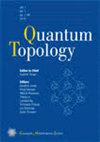$3^n$子因子的分类及相关的融合范畴
IF 1
2区 数学
Q1 MATHEMATICS
引用次数: 15
摘要
我们研究了一个(可能无限的)子因子序列,称为$3^n$子因子,包括$A_4$, $A_7$和Haagerup子因子作为对应于$n=1,2,3$的前三个元素。在此基础上,我们进一步发展了一种构造3^n$子因子的Cuntz代数方法,并证明了3^n$子因子和相关融合类别的分类在一个温和的假设下可以简化为显式多项式方程,该假设自动适用于奇数$n$。特别地,我们的方法在$n=4$的情况下给出了4个有限深度子因子的统一构造,直到对偶,没有索引$3+\sqrt{5}$的中间子因子。由于Grossman、Snyder和作者的贡献,这也为Asaeda-Haagerup子因子的新构建提供了关键的一步。本文章由计算机程序翻译,如有差异,请以英文原文为准。
The classification of $3^n$ subfactors and related fusion categories
We investigate a (potentially infinite) series of subfactors, called $3^n$ subfactors, including $A_4$, $A_7$, and the Haagerup subfactor as the first three members corresponding to $n=1,2,3$. Generalizing our previous work for odd $n$, we further develop a Cuntz algebra method to construct $3^n$ subfactors and show that the classification of the $3^n$ subfactors and related fusion categories is reduced to explicit polynomial equations under a mild assumption, which automatically holds for odd $n$.In particular, our method with $n=4$ gives a uniform construction of 4 finite depth subfactors, up to dual,without intermediate subfactors of index $3+\sqrt{5}$. It also provides a key step for a new construction of the Asaeda-Haagerup subfactor due to Grossman, Snyder, and the author.
求助全文
通过发布文献求助,成功后即可免费获取论文全文。
去求助
来源期刊

Quantum Topology
Mathematics-Geometry and Topology
CiteScore
1.80
自引率
9.10%
发文量
8
期刊介绍:
Quantum Topology is a peer reviewed journal dedicated to publishing original research articles, short communications, and surveys in quantum topology and related areas of mathematics. Topics covered include in particular:
Low-dimensional Topology
Knot Theory
Jones Polynomial and Khovanov Homology
Topological Quantum Field Theory
Quantum Groups and Hopf Algebras
Mapping Class Groups and Teichmüller space
Categorification
Braid Groups and Braided Categories
Fusion Categories
Subfactors and Planar Algebras
Contact and Symplectic Topology
Topological Methods in Physics.
 求助内容:
求助内容: 应助结果提醒方式:
应助结果提醒方式:


